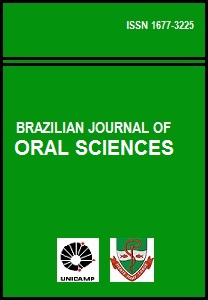Abstract
Aim: To evaluate the profile of the colonization by Candida spp. using presumptive identification to classify the patients with denture stomatitis as having single or mixed colonization, correlating with oral and systemic status. Methods: The CHROMagar Candida™ Medium (CC) for yeast culture and exfoliative cytology was used to identify colonization by Candida spp. and distinguish the different species of the Candida genus from patients with denture stomatitis (DS) and denture wearers without DS (control group). In addition, colonization was correlated with specific habits, such as tobacco and alcohol use, as well as with the use of systemic drugs. Results: Direct swabbing of whole unstimulated saliva (WUS) and palatal mucosa revealed colonization in 97.3% of the patients with DS. In the control group, 55.0% patients presented colonization. The presumptive identification found C. albicans as the most prevalent between both groups, respectively in 89.4% of the DS group and 40.0% from the control group. Regarding the nonalbicans species in the DS group, the most frequent were C. krusei (31.5%), C. glabrata (21.0%) C. tropicalis (15.7%) and Candida spp (2.6%). Smokers presented 90% of mixed isolates, and no C.albicans single colonization in the DS group, with statistically significant difference between smokers and non-smokers (p=0.0051). In the control group, the non-albicans species were C.glabrata (23.0%) and C.tropicalis (23.0%). The results of cytology from the DS group showed positive results in 22.2% of the cases. Conclusions: The use of CC was effective as a complementary method for the diagnosis of colonization by Candida spp. and DS, with the additional advantage of enabling a rapid presumptive identification of the specie. Smoking seemed to play a role in the colonization of oral mucosa by mixed albicans and non-albicans species. Mixed colonization seems to be more prevalent between patients with DS.The Brazilian Journal of Oral Sciences uses the Creative Commons license (CC), thus preserving the integrity of the articles in an open access environment.
Downloads
Download data is not yet available.

